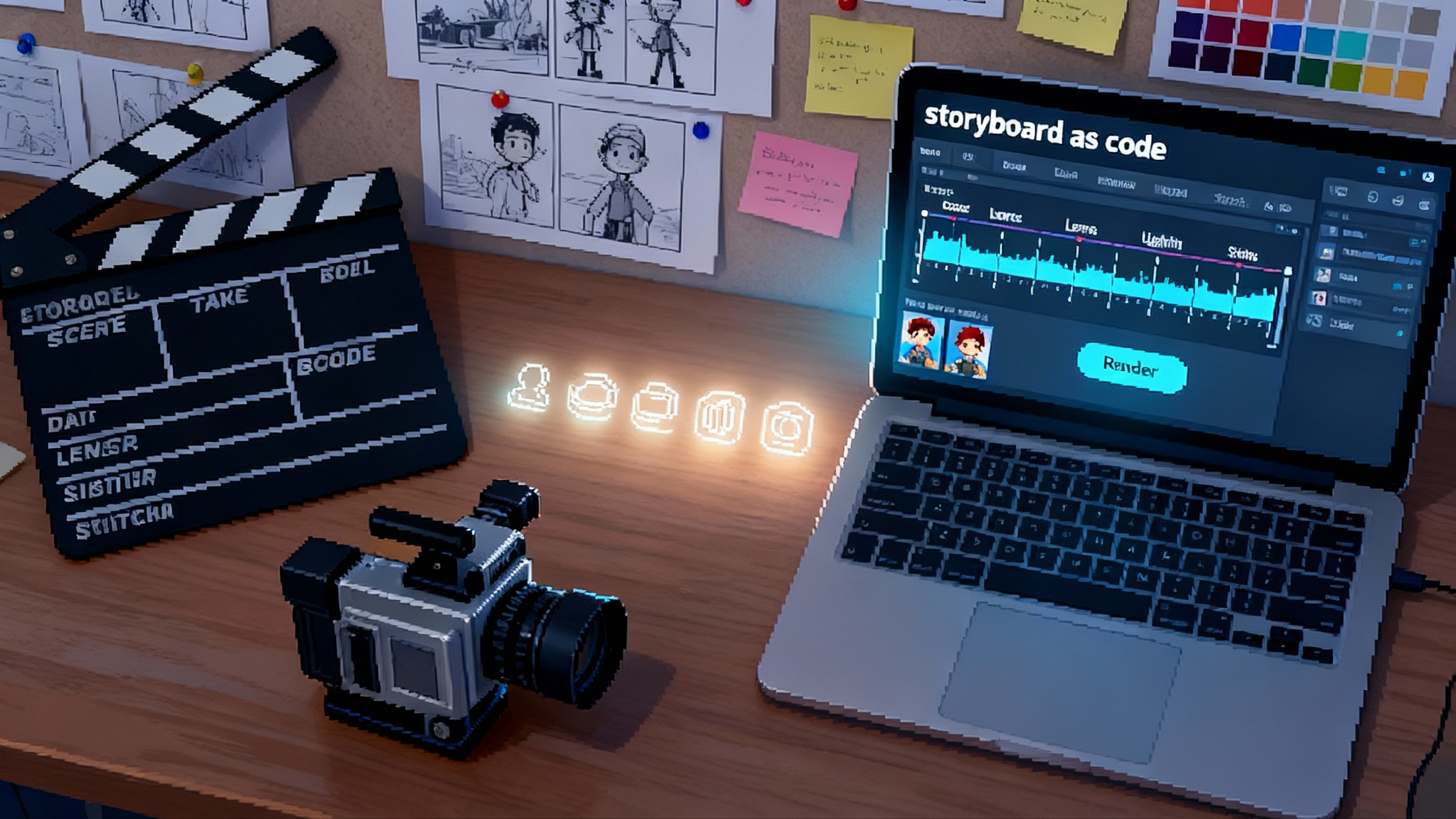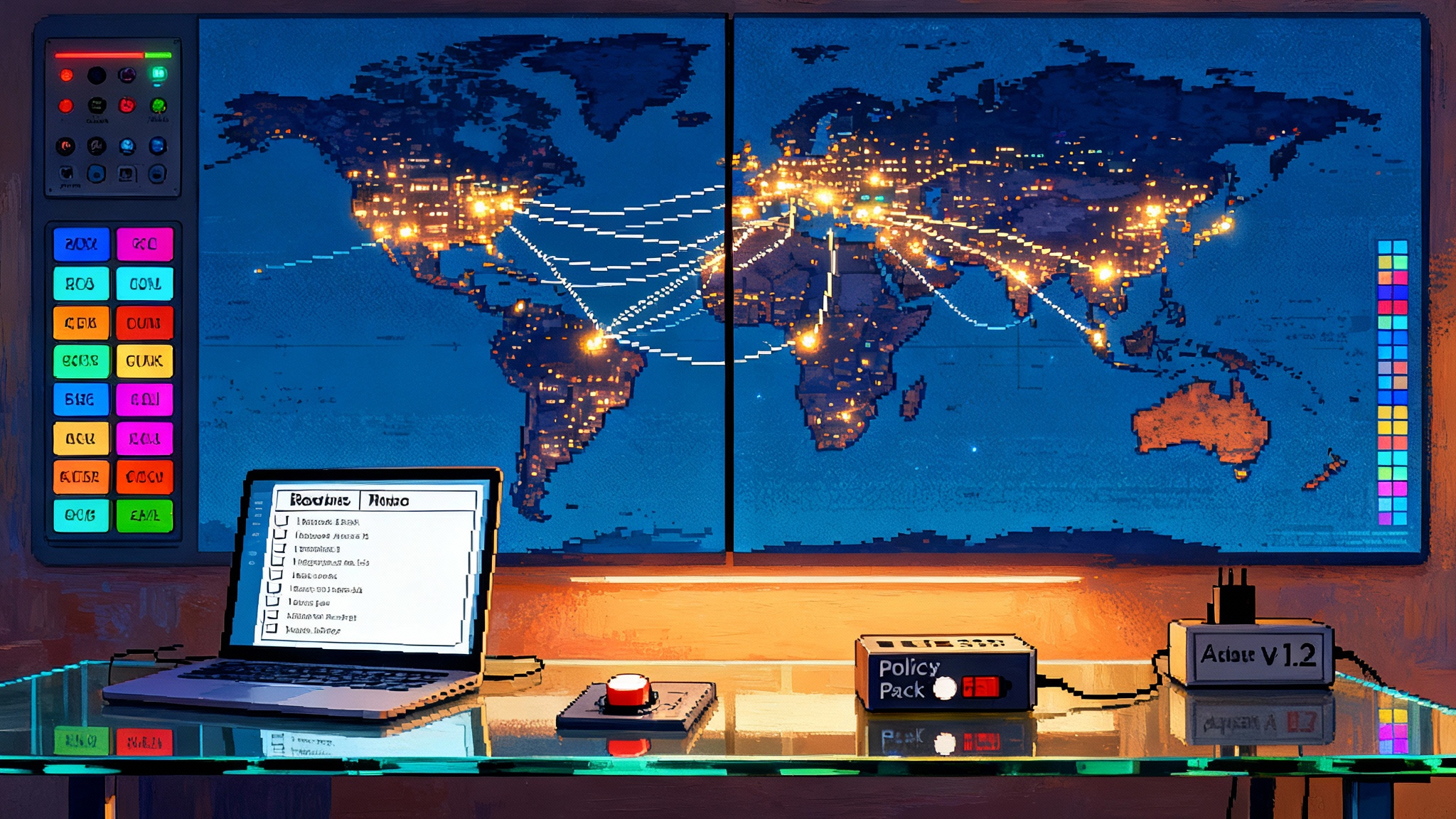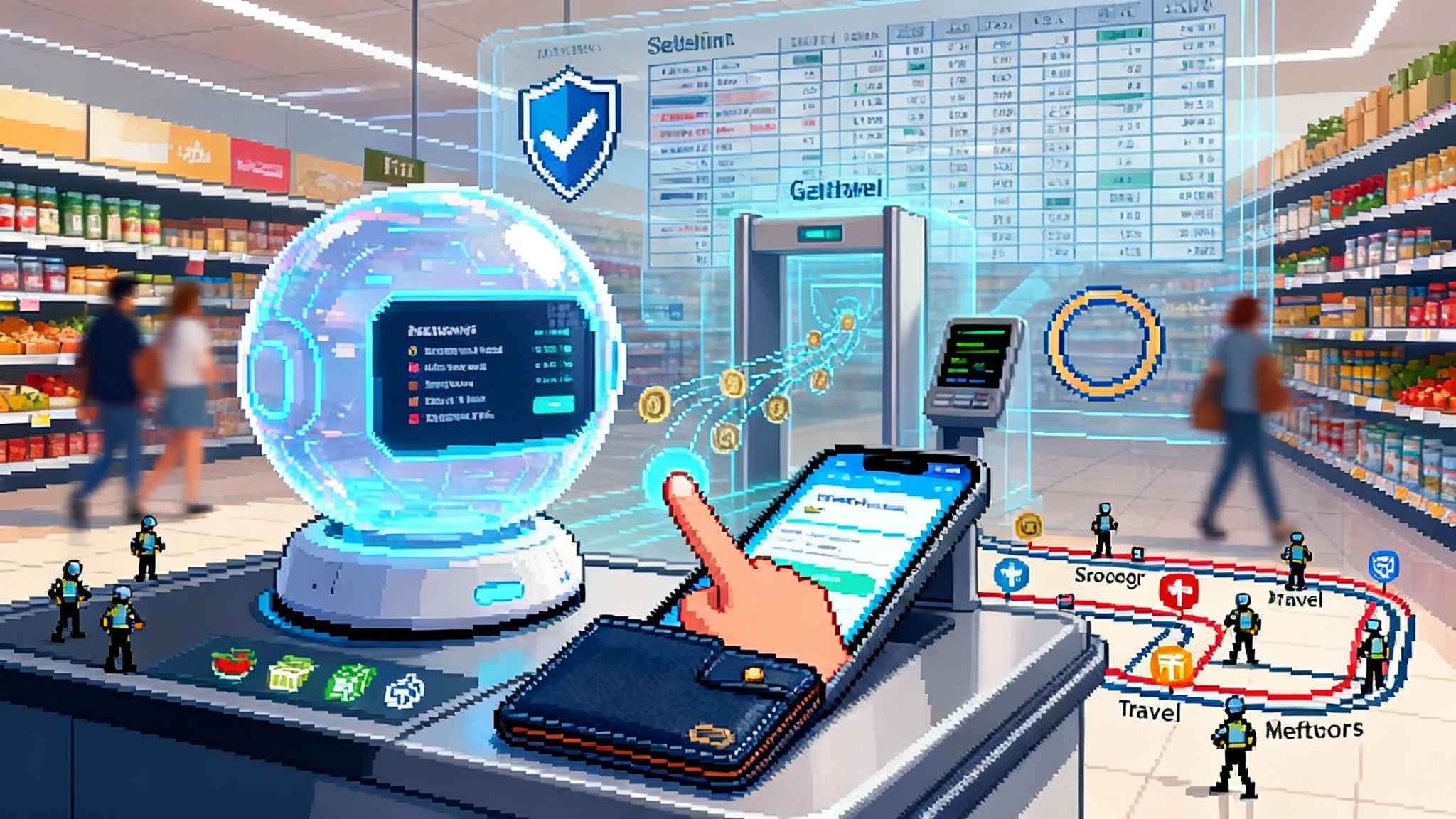Writeable Reality: After Sora 2, Video Becomes Code
OpenAI Sora 2 pushes video beyond editing into executable intent. With APIs, storyboards as code, reusable characters, and stitching, timelines become programmable while consent and provenance move into the workflow.

The moment moving images became programmable
In late 2025, OpenAI's Sora 2 moved from a dazzling demo to a platform you can actually build on. The company opened app access for everyday creators and API access for developers, then shipped updates that matter to anyone who works in pictures and sound: longer clips, reusable characters, stitching, and synchronized audio. The practical result is simple and profound. The timeline is no longer just a place where you drag clips. It is a canvas where you describe what should happen and let the system realize it. OpenAI framed Sora 2 as a step toward world simulation, but the immediate shift is even clearer. Video is becoming a programming medium. For context, see the OpenAI's Sora 2 announcement.
We have crossed a philosophical threshold. For over a century, we treated moving images like a window that captures light from the world. With Sora 2, video starts to behave like a compiled artifact of human intent. You still point at reality when you want to, but you can also specify a scene, a camera move, a line of dialog, and a character’s continuity, and the system renders it into time.
From captured truth to compiled intent
Consider a court re-enactment. In the old world, a legal team would hire animators to approximate an event, then disclaimers would warn the jury that what they were watching was illustrative. In a writeable reality, a team can specify constraints, ask the model to generate physics-consistent alternatives, and explore a space of explanations with the precision of a spreadsheet. The moving image becomes something you version, test, and audit. The artifact is not merely a picture of what happened. It is a record of what you asked for.
That shift reverberates beyond courts. Newsrooms will treat video like a document with lineage and a change history. Brands will treat campaigns like software releases that move from alpha to stable. Educators will generate lab-like simulations where a change to one variable recomputes the rest. When video is programmable, the boundary between pre-production, production, and post dissolves into one loop: write, render, review, revise.
As storytelling turns agentic, creative organizations will also need identity and permissioning models that match the new reality. People, characters, and software agents will share the same stage, which elevates the need for an identity fabric. For a broader view of that direction, see how the agent identity layer arrives.
What changed with Sora 2
The obvious changes are faster iteration and finer control. The deeper change is that Sora 2 moves authoring from frame-by-frame manipulation to constraint-based description. OpenAI supports this shift with practical tools that turn ideas into a structured spec. Storyboards let you express a sequence as an editable plan. Stitching connects multiple clips into one arc. Reusable cameos make characters portable between scenes with continuity and consent. These are not just conveniences. They push every creator toward the same abstractions professional pipelines use, but with far less friction. For details on these features, see the OpenAI help center’s guidance on Sora storyboards and stitching.
For developers, API access changes the mental model. Shots, scenes, and characters become first-class objects you can store, reuse, and transform. An app can generate options in parallel, prune with heuristics, and surface a ranked shortlist. A service can guarantee continuity across episodes or courses by reusing the same character spec and camera grammar. Latency matters, but so does determinism. Seed control and lens parameters make reproducibility a feature. You can re-render a shot months later and preserve framing, lighting, and motion behavior.
Storyboards as code
If you have ever written a design doc, you already understand the logic behind Sora’s storyboard model. A storyboard in this world is a lightweight program. You define:
- Characters: inputs and states such as wardrobe, voice, and emotional baseline
- Locations: lighting, time of day, composition constraints
- Camera instructions: lens, movement, and pacing
- Beats: the semantic events that must unfold in order
- Audio intent: ambience, effects, and dialog
Instead of nudging keyframes, you describe invariants and let the system fill the in-betweens. Think of it like writing a recipe rather than arranging every molecule on the plate. The advantages are speed, reuse, and clarity. If you decide that the protagonist should wear a denim jacket, you change one variable and regenerate the sequence. If you want a slower push-in, you adjust pacing and render again without relighting or re-rigging. Teams start to feel like software teams. They work from a shared spec, branch experiments, and converge on a cut.
The editorial stack for trust
When video becomes code, trust cannot rely on vibes. We need provenance. The good news is that the tools exist. The Coalition for Content Provenance and Authenticity (C2PA) publishes an open standard for recording who made or changed a piece of media and how. Content Credentials, built on that standard, attach tamper-evident metadata at capture or export so that anyone can inspect an asset’s origin and edit history. Think of it as a nutrition label for pixels.
Provenance alone is not enough. We also need clear disclosure and consistent interface patterns. Platforms should surface labels in the same place on every video. Inspectors should be one tap away, not hidden behind a menu. Most of all, credentials should travel with the file from camera to editor to social feed. If the chain breaks, the interface should tell you that the history is incomplete and why, rather than silently dropping context.
This is where compliance and governance become product features rather than policy documents. Tying credentials to renders, permissions to cameos, and disclosure to feeds creates a coherent trust stack that can scale. For a wider view of how compliance becomes a strategic advantage, see why compliance becomes the new moat.
The new roles on set
Programmable video does not delete labor. It reshapes it. Some roles morph and new roles appear:
- Director as system designer: sets creative constraints, defines the spec, and supervises the generation loop
- Promptwright: crafts the textual and structural instructions that reliably yield desired style and blocking
- Character wrangler: manages reusable characters and cameos, including consent, continuity, and performance notes
- Data and rights manager: maintains licenses, consent receipts, and model usage policies, and ensures credentials embed correctly
- Editor as conductor: orchestrates clips, stitches arcs, and sets pacing while exploring variants with agentic tools
- Model operator: tunes parameters, seeds, and negative prompts, and monitors quality metrics like motion consistency and lip sync
These jobs require taste and judgment more than manual keyframing. They also create new entry points into the industry. A student who can specify a beautiful scene with precise constraints will be valuable on day one.
Product and UX shifts to expect in the next 12 months
Here is what will likely appear across creative tools soon, because Sora 2’s model and APIs make them natural to build:
- Sub-second iteration loops: preview passes render quickly at lower fidelity, then refine without restarting, so creative flow feels like typing and seeing
- Agentic editors: assistants translate natural language notes into precise storyboard edits, retime shots, and keep continuity across scenes
- Reusable characters as libraries: cameos and character specs become versioned assets that teams permission like fonts or color palettes
- Stitch-first timelines: non-linear editors treat shots as atomic units for composition while the system handles transitions and continuity
- Constraint panels instead of sliders: interfaces expose high-level goals such as mood, wardrobe continuity, and camera grammar, while the model chooses micro-parameters
- Variation grids with memory: the app learns what you accept or reject, then proposes choices that match your taste and project rules
- Seed and lens control as first-class: reproducibility becomes predictable, not accidental
- Provenance baked into export: every render signs with credentials by default, and editors warn you before a chain of custody breaks
These capabilities also push infrastructure choices. Systems that prioritize low-latency orchestration, shared caches, and deterministic rendering will win. This aligns with a broader shift in AI from prompt art to dependable plumbing. If you are planning the next wave of creative infrastructure, it helps to build the pipes, not the prompts.
Economic spillovers to plan for
- Advertising: Versioning explodes. You can generate a hundred variants of a six-second pre-roll, each tuned to context, audience, and offer. The limiting factor becomes testing discipline and brand governance rather than production budget.
- Education: Instructors assemble concept videos like problem sets, with parameters for difficulty and style. A physics lecture can switch to an experiment view where friction or mass become knobs that change the simulation.
- Simulation and design: Product teams previsualize environments and interfaces as living scenes, then export both marketing assets and training data from the same spec. Robotics and autonomy groups generate edge cases in bulk and review them like unit tests.
- Small business and creators: Local shops shoot fewer traditional ads and instead program short loops that look like they hired a film crew. Ubiquity creates pressure for authenticity labels so viewers can still tell when something was actually captured in the world.
Governance trade-offs we cannot dodge
Consent is not a checkbox. If your character library contains a person, you need a reusable consent record, not a one-time signature. If your pipeline can plant a face into any scene, your policies must restrict where and how that face appears. These requirements are not theoretical. They are practical constraints in a world where a single specification can produce endless footage.
Disclosure must be consistent and legible. A tiny icon in a corner is not enough. People should know at a glance whether they are watching captured light or compiled intent. That does not mean shaming synthetic media. It means telling the truth about what something is and how it came to be.
Regulation will sprint to keep up, but we do not have to wait. Courts can set admissibility rules that require credentials and clear chains of custody for any synthetic re-enactment. Newsrooms can adopt provenance checks as a standard desk function, just like fact-checking. Platforms can label and throttle content that arrives without credentials during breaking news events when the risk of harm is high.
A forward-looking blueprint for credible media
Here is a concrete plan that developers, media organizations, platforms, and policymakers can start implementing now:
- Capture-side signing
- What: Enable signing at the moment of capture for cameras and recorders, and preserve signatures through edit and export
- Why: You need to prove what entered the pipeline was real or disclose when it was not
- How: Ship firmware updates and plugin bridges that add credential signing to capture devices and ingest apps
- Default Content Credentials
- What: Turn on credentials by default in creative tools and programmatic renderers
- Why: Silent drops in provenance create confusion and invite abuse
- How: Embed credentials on export and warn on removal; pass credentials through cloud storage and content delivery networks
- Consent and cameo registries
- What: Store reusable consent receipts for people who appear as characters, with scope and expiration
- Why: Reusable characters are powerful, and power without consent is a liability
- How: Use a consent object in your asset manager, link it to character specs, and enforce at render time
- Provenance-aware feeds
- What: Place consistent labels on synthetic media and enable a one-tap inspector that shows an asset’s history
- Why: People need clarity at the speed of scrolling
- How: Standardize badge placement and detection; integrate the inspector as a built-in overlay rather than a separate site
- Sub-second preview loops
- What: Make low-latency previews the default so creators can iterate like writers
- Why: Creativity thrives on quick feedback
- How: Use cached latents and partial renders; queue full-resolution passes in the background
- Agentic edit checkers
- What: Agents that enforce project rules before export, such as continuity, consent scope, and brand safety
- Why: Most mistakes are predictable and preventable
- How: Encode constraints as tests; fail builds that violate them and suggest automatic fixes
- Curriculum for visual literacies
- What: Teach compiled intent in schools and workplaces
- Why: People must learn to read synthetic video the way they learned to read essays and spreadsheets
- How: Build short modules that show how prompts change outcomes, how provenance works, and how to spot missing context
- Ad market standards
- What: Require credentials for synthetic ads and include a disclosure flag in ad markup
- Why: Trust is part of performance; without it, regulators and platforms will choke distribution
- How: Update partner programs and ad verification tools to check for credentials before trafficking
- Newsroom protocols
- What: Treat the authenticity check as a standard desk, with publish blockers when provenance is missing in sensitive stories
- Why: The speed of generation will otherwise outrun editorial checks
- How: Bake verification into content management systems with a traffic-light status and required sign-off
- Open model cards for media models
- What: Rich model cards that list training data policies, known failure modes, and watermarking behavior
- Why: Users and auditors need to know what the system tends to get wrong
- How: Publish clear cards and update them when new capabilities or safety changes ship
The business case for acceleration
Bans feel tidy. They also create a shadow market without guardrails. Acceleration with the right infrastructure does the opposite. When provenance is easy, consent routine, and disclosure visible, the benefits of programmable video compound while costs stay bounded. Creators gain leverage. Viewers gain clarity. Institutions gain tools they can enforce.
You can already see this logic in Sora 2’s direction. The updates that enable more control, such as storyboards and stitching, also enable better governance, because they turn video into a structure you can inspect and sign. That is the path worth accelerating.
A practical playbook for teams today
If you are responsible for a creative pipeline, here is how to get started without waiting for anyone else:
- Codify your house style as constraints: define camera grammar, pacing bands, wardrobe palettes, and dialog tone. Make these parameters first-class settings in your storyboard templates.
- Create a character library with consent: for each actor or persona, build a spec that includes voice, wardrobe, emotional baseline, and scope of consent. Track expiration and revocation.
- Instrument your timeline for provenance: enable credentials on export and audit every step where metadata could drop. Treat a missing signature like a test failure.
- Teach producers to think in versions: encourage branches for risky ideas and require a short rationale for every approve or reject decision so the system can learn your taste.
- Tie your editor to an agentic assistant: let it convert plain-English notes into precise edits, cue up variations, and maintain continuity between shots.
- Measure quality with stable metrics: track motion consistency, lip sync, color continuity, and audio alignment. Review a weekly dashboard and refine your constraints as you learn.
The closing scene
The camera used to be a net we cast into the world. With Sora 2 and its ecosystem, it becomes a compiler for intention. Shots become functions you call. Characters become instances you reuse. Timelines become programs you can version and sign. If we pair that power with provenance, consent, and new visual literacies, we can build a media system that is faster, more creative, and more credible. The next wave of moving images will not only show what happened. They will show what we meant to make happen, and they will tell us how we made it.
To keep that promise, treat Sora 2 not as a toy but as a turning point. Build constraints into your craft. Build provenance into your pipeline. Build consent into your casting. Then press render and let your intent compile.








